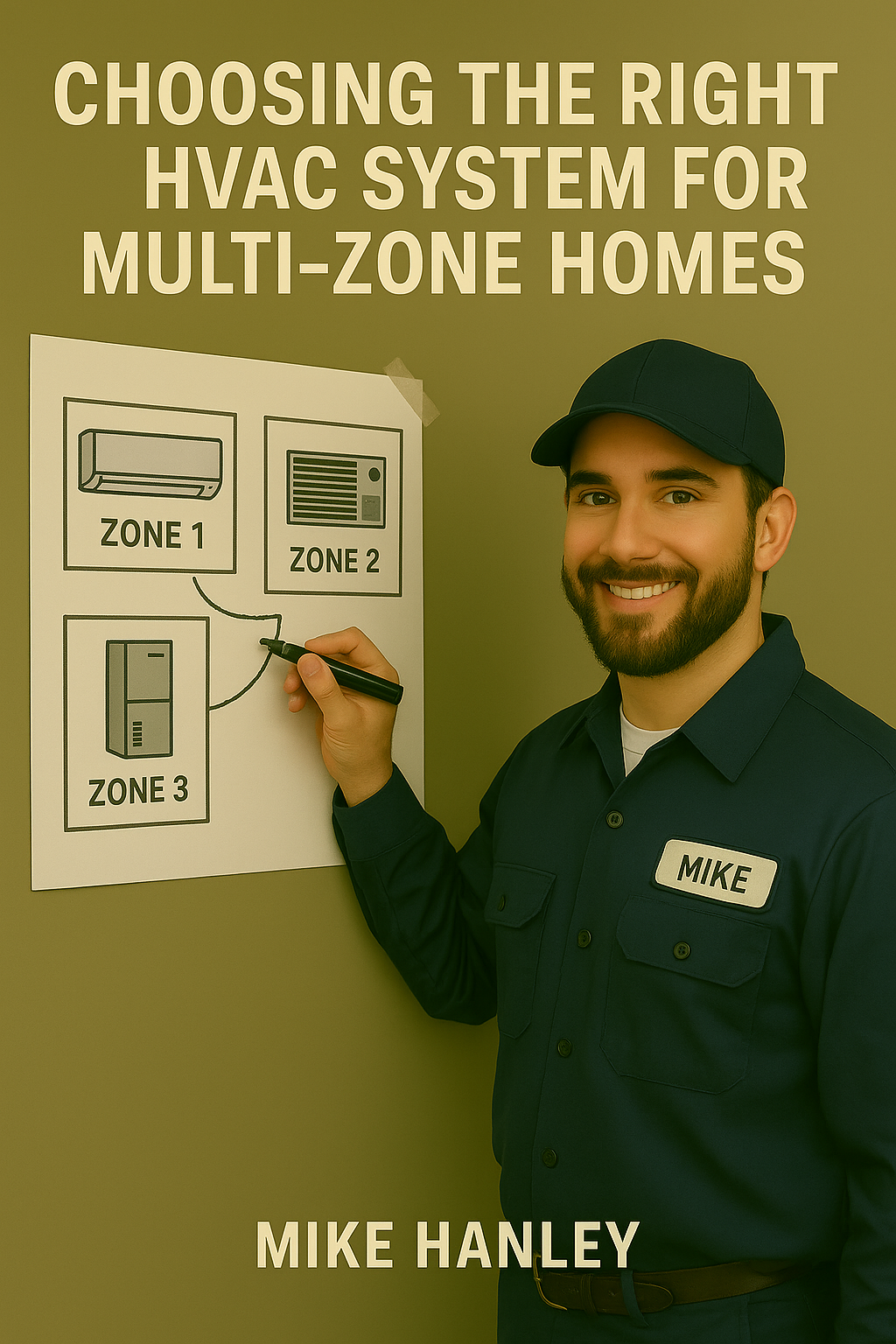📘 Table of Contents
🏠 Why Multi‑Zone Decision Matters
Choosing the right HVAC system for a multi‑zone home isn’t just a comfort decision—it shapes how efficiently your system runs, how much you’ll spend on energy, and how well individual rooms stay balanced year-round.
Whether you’re working with a two-story layout, a sprawling ranch, or a home with unique additions like sunrooms or garages, zoning matters. Your system must adapt to different heating and cooling needs across the space. That’s where solutions like mini‑splits, VRF systems, and smart ducted zones come into play.
❄️ Mini‑Split vs VRF vs Horizontal Package Units
This table outlines the main multi-zone HVAC options and how they differ in zoning, complexity, and best-use scenarios:
|
System Type |
Zoning Flexibility |
Installation Complexity |
Ideal For |
|
Mini‑Split |
Up to 8 indoor heads |
Medium (DIY or pro options) |
Fast installs, ductless homes, retrofit areas |
|
VRF / VRV |
Deep zoning (vari‑speed) |
Professional-only |
Large homes with many zones, flexible capacity |
|
Horizontal Package Unit |
Zoning via ducted branches |
Moderate (requires duct planning) |
Ranch‑style, slab/grade layouts with zones |
Mini‑splits offer up to 5 zones per condenser. Examples like the 3‑zone MRCOOL system can fully replace traditional setups in the right layout.
Horizontal package units can also work if paired with smart duct zoning and dampers.
For homes without existing ductwork, ductless mini‑splits offer flexibility and cost-effective zoning. If you already have ducts and need to serve multiple branches from one outdoor unit, a horizontal package unit paired with zoning accessories may be ideal.
🏠 Match System to Your Home’s Layout
Layout is a major factor when selecting a zoning system:
-
Split-level or two-story homes benefit from using zone-specific indoor heads. A 12k BTU unit can handle a downstairs open area, while 9k units handle bedrooms upstairs.
-
Open-concept homes often need a large indoor head (like 24k BTU) in the living space with smaller heads in adjacent areas.
-
Add-ons or enclosed spaces like garages, sunrooms, or workshops are ideal candidates for single-head ductless units added onto a multi-zone system.
A properly zoned setup ensures each area of your home receives balanced airflow without wasting energy in rooms that don’t need constant conditioning. For real-world examples, look up zoned HVAC strategies.
💨 Zoning with Dampers, DOAS & VAV Systems
Ducted systems can achieve zoning using control devices rather than separate equipment per room. Common zoning components include:
-
Motorized dampers: These adjust airflow within duct branches to control room temperatures independently.
-
VAV (Variable Air Volume) systems: Fine-tune airflow dynamically for each zone using temperature feedback.
-
DOAS (Dedicated Outdoor Air Systems): These supplement main HVAC units to manage ventilation and humidity in large or high-occupancy homes.
To make ducted zoning work efficiently, pair it with Manual D duct design and programmable thermostats that control individual zones.
📇 Mini‑Split Brands, Capacity, and Installation Tips
Mini-splits are an increasingly popular choice for multi-zone systems thanks to their ease of zoning and energy efficiency. Here’s how to choose the right setup:
✅ Brands & Features
-
MRCOOL DIY systems offer factory pre-charged lines, smartphone control, and DIY-friendly installation.
-
Goodman and Daikin offer professional-grade systems with greater durability and extended warranties, but require licensed installation.
✅ Sizing and Capacity
Match BTU capacity to room size:
-
9k BTU = ~400 sq ft (bedroom or office)
-
12k–18k BTU = larger living areas
-
24k+ BTU = open floor plans
A 48k BTU system can support up to 5 zones, depending on configuration. Use a Manual J calculation to prevent over- or undersizing.
✅ Installation Notes
-
Respect manufacturer line-set limits (e.g., 82 ft per indoor unit, 165 ft total)
-
Keep indoor head placement centered on walls for even airflow
-
Leave proper clearance for outdoor condensers to ensure ventilation
Need a guide? See our Mini‑Split Installation Tips & Sizing Guide.
✅ Key Takeaways & Next Steps
Multi-zone HVAC systems give you control, efficiency, and adaptability when chosen carefully:
-
Use mini‑splits for ductless zoning and room-level control
-
Choose VRF systems for larger homes with highly variable needs
-
Use package units with smart dampers for centralized systems
-
Always size using Manual J, and design ducts using Manual D when applicable
Explore the rest of this series to compare solutions side by side:
➡️ Part 2: Choosing Mini‑Splits vs VRF for Multi-Zone Homes
➡️ Part 3: Matching System Layout to Home Design
➡️ Part 4: Zoning with Dampers, DOAS & VAV Explained
➡️ Part 5: Horizontal Package Units for Multi‑Zone Homes
❓FAQ
Q: Can I DIY a multi-zone system?
A: Yes, with pre-charged mini-split kits like MRCOOL. VRF and zoned ducted systems require professional installation.
Q: How many zones can a mini-split support?
A: Most support 2–5 heads, depending on BTU rating and system specs. Check your condenser's zone limit.
Q: Should I oversize for future add-ons?
A: No. Oversizing causes cycling, poor humidity control, and energy waste. Size for your actual load.
Q: Will dampers reduce airflow too much?
A: Not if designed correctly. Use Manual D and variable-speed blowers to maintain balanced pressure.
Q: Which system works best for open-concept layouts?
A: Mini-splits or packaged units with zoning both work, choose based on duct access, head count, and budget.







